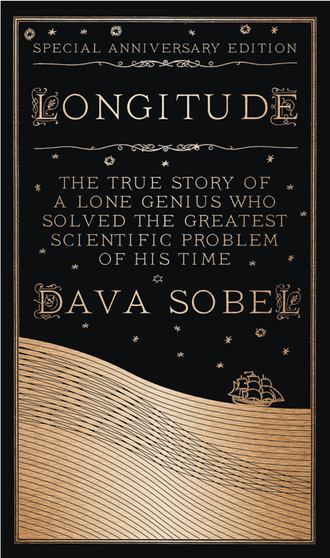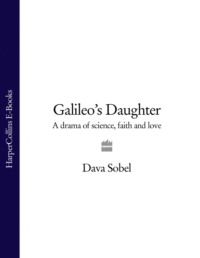
Полная версия
Longitude
4. Time in a Bottle
There being no mystic communion of clocks it hardly matters when this autumn breeze wheeled down from the sun to make leaves skirt pavement like a million lemmings.
An event is such a little piece of time-and-space you can mail it through the slotted eye of a cat.
—DIANE ACKERMAN, “Mystic Communion of Clocks”
Time is to clock as mind is to brain. The clock or watch somehow contains the time. And yet time refuses to be bottled up like a genie stuffed in a lamp. Whether it flows as sand or turns on wheels within wheels, time escapes irretrievably, while we watch. Even when the bulbs of the hourglass shatter, when darkness withholds the shadow from the sundial, when the mainspring winds down so far that the clock hands hold still as death, time itself keeps on. The most we can hope a watch to do is mark that progress. And since time sets its own tempo, like a heartbeat or an ebb tide, timepieces don’t really keep time. They just keep up with it, if they’re able.
Some clock enthusiasts suspected that good timekeepers might suffice to solve the longitude problem, by enabling mariners to carry the home-port time aboard ship with them, like a barrel of water or a side of beef. Starting in 1530, Flemish astronomer Gemma Frisius hailed the mechanical clock as a contender in the effort to find longitude at sea.
“In our times we have seen the appearance of various small clocks, capably constructed, which, for their modest dimensions, provide no problem to those who travel,” Frisius wrote. He must have meant they provided no problem of heft or high price to rich travelers; certainly they did not keep time very well. “And it is with their help that the longitude can be found.” The two conditions that Frisius spelled out, however—namely, that the clock be set to the hour of departure with “the greatest exactness” and that it not be allowed to run down during the voyage—virtually ruled out any chance of applying the method at that time. The clocks of the early sixteenth century weren’t equal to the task. They were neither accurate nor able to run true against the assault of changing temperature on the high seas.
Although it is not clear whether he knew of Gemma Frisius’s suggestion, William Cunningham of England revived the timekeeper idea in 1559, recommending watches “such as are brought from Flanders” or found “without Temple barre,” right in London, for the purpose. But these watches typically gained or lost as many as fifteen minutes a day, and thus fell far short of the accuracy required to determine one’s whereabouts. (Multiplying a difference in hours by fifteen degrees gives only an approximation of location; one also needs to divide the number of minutes and seconds by four, to convert the time readings to degrees and minutes of arc.) Nor had timepieces enjoyed any significant advances by 1622, when English navigator Thomas Blundeville proposed using “some true Horologie or Watch” to determine longitude on transoceanic voyages.
The shortcomings of the watch, however, failed to squelch the dream of what it might do once perfected.
Galileo, who, as a young medical student, successfully applied a pendulum to the problem of taking pulses, late in life hatched plans for the first pendulum clock. In June of 1637, according to Galileo’s protege and biographer, Vincenzo Viviani, the great man described his idea for adapting the pendulum “to clocks with wheelwork for assisting the navigator to determine his longitude.”
Legends of Galileo recount an early mystical experience in church that fostered his profound insights about the pendulum as timekeeper: Mesmerized by the to-and-fro of an oil lamp suspended from the nave ceiling and pushed by drafts, he watched as the sexton stopped the pan to light the wick. Rekindled and released with a shove, the chandelier began to swing again, describing a larger arc this time. Timing the motion of the lamp by his own pulse, Galileo saw that the length of a pendulum determines its rate.
Galileo always intended to put this remarkable observation to work in a pendulum clock, but he never got around to building one. His son, Vincenzio, constructed a model from Galileo’s drawings, and the city fathers of Florence later built a tower clock predicated on that design. However, the distinction for completing the first working pendulum clock fell to Galileo’s intellectual heir, Christiaan Huygens, the landed son of a Dutch diplomat who made science his life.
Huygens, also a gifted astronomer, had divined that the “moons” Galileo observed at Saturn were really a ring, impossible as that seemed at the time. Huygens also discovered Saturn’s largest moon, which he named Titan, and was the first to notice markings on Mars. But Huygens couldn’t be tied to the telescope all the time. He had too many other things on his mind. It is even said that he chided Cassini, his boss at the Paris Observatory, for the director’s slavish devotion to daily observing.
Huygens, best known as the first great horologist, swore he arrived at the idea for the pendulum clock independently of Galileo. And indeed he evinced a deeper understanding of the physics of pendulum swings—and the problem of keeping them going at a constant rate—when he built his first pendulum-regulated clock in 1656. Two years later Huygens published a treatise on its principles, called the Horologium, in which he declared his clock a fit instrument for establishing longitude at sea.
By 1660, Huygens had completed not one but two marine timekeepers based on his principles. He tested them carefully over the next several years, sending them off with cooperative sea captains. On the third such trial, in 1664, Huygens’s clocks sailed to the Cape Verde Islands, in the North Atlantic off the west coast of Africa, and kept good track of the ship’s longitude all the way there and back.
Now a recognized authority on the subject, Huygens published another book in 1665, the Kort Onderwys, his directions for the use of marine timekeepers. Subsequent voyages, however, exposed a certain finickiness in these machines. They seemed to require favorable weather to perform faithfully. The swaying of the ship on a storm’s waves confounded the normal swinging of the pendulum.
To circumvent this problem, Huygens invented the spiral balance spring as an alternative to the pendulum for setting a clock’s rate, and had it patented in France in 1675. Once again, Huygens found himself under pressure to prove himself the inventor of a new advance in timekeeping, when he met a hot-blooded and headstrong competitor in the person of Robert Hooke.
Hooke had already made several memorable names for himself in science. As a biologist studying the microscopic structure of insect parts, bird feathers, and fish scales, he applied the word cell to describe the tiny chambers he discerned in living forms. Hooke was also a surveyor and builder who helped reconstruct the city of London after the great fire of 1666. As a physicist, Hooke had his hand in fathoming the behavior of light, the theory of gravity, the feasibility of steam engines, the cause of earthquakes, and the action of springs. Here, in the coiled contrivance of the balance spring, Hooke clashed with Huygens, claiming the Dutchman had stolen his concept.
The Hooke-Huygens conflict over the right to an English patent for the spiral balance spring disrupted several meetings of the Royal Society, and eventually the matter was dropped from the minutes, without being decided to either contestant’s satisfaction.
In the end, there was no end to the strife, though neither Hooke nor Huygens produced a true marine timekeeper. The separate failures of these two giants seemed to dampen the prospects for ever solving the longitude problem with a clock. Disdainful astronomers, still struggling to amass the necessary data required to employ their lunar distance technique, leaped at the chance to renounce the timekeeper approach. As far as they could see, the answer would come from the heavens—from the clockwork universe and not from any ordinary clock.
5. Powder of Sympathy
The College will the whole world measure;
Which most impossible conclude,
And Navigation make a pleasure
By finding out the Longitude.
Every Tarpaulin shall then with ease
Sayle any ship to the Antipodes.
—ANONYMOUS (ABOUT 1660) “Ballad of Gresham College”
At the end of the seventeenth century, even as members of learned societies debated the means to a longitude solution, countless cranks and opportunists published pamphlets to promulgate their own hare-brained schemes for finding longitude at sea.
Surely the most colorful of the offbeat approaches was the wounded dog theory, put forth in 1687. It was predicated on a quack cure called powder of sympathy. This miraculous powder, discovered in southern France by the dashing Sir Kenelm Digby, could purportedly heal at a distance. All one had to do to unleash its magic was to apply it to an article from the ailing person. A bit of bandage from a wound, for example, when sprinkled with powder of sympathy, would hasten the closing of that wound. Unfortunately, the cure was not painless, and Sir Kenelm was rumored to have made his patients jump by powdering—for medicinal purposes—the knives that had cut them, or by dipping their dressings into a solution of the powder.
The daft idea to apply Digby’s powder to the longitude problem follows naturally enough to the prepared mind: Send aboard a wounded dog as a ship sets sail. Leave ashore a trusted individual to dip the dog’s bandage into the sympathy solution every day at noon. The dog would perforce yelp in reaction, and thereby provide the captain a time cue. The dog’s cry would mean, “the Sun is upon the Meridian in London.” The captain could then compare that hour to the local time on ship and figure the longitude accordingly. One had to hope, of course, that the powder really held the power to be felt many thousand leagues over the sea, and yet—and this is very important—fail to heal the telltale wound over the course of several months. (Some historians suggest that the dog might have had to be injured more than once on a major voyage.)
Whether this longitude solution was intended as science or satire, the author points out that submitting “a Dog to the misery of having always a Wound about him” is no more macabre or mercenary than expecting a seaman to put out his own eye for the purposes of navigation. “[B]efore the Back-Quadrants were Invented,” the pamphlet states, “when the Forestaff was most in use, there was not one Old Master of a Ship amongst Twenty, but what a Blind in one Eye by daily staring in the Sun to find his Way.” This was true enough. When English navigator and explorer John Davis introduced the backstaff in 1595, sailors immediately hailed it as a great improvement over the old cross-staff, or Jacob’s staff. The original sighting sticks had required them to measure the height of the sun above the horizon by looking directly into its glare, with only scant eye protection afforded by the darkened bits of glass on the instruments’ sighting holes. A few years of such observations were enough to destroy anyone’s eyesight. Yet the observations had to be made. And after all those early navigators lost at least half their vision finding the latitude, who would wince at wounding a few wretched dogs in the quest for longitude?
Конец ознакомительного фрагмента.
Текст предоставлен ООО «ЛитРес».
Прочитайте эту книгу целиком, купив полную легальную версию на ЛитРес.
Безопасно оплатить книгу можно банковской картой Visa, MasterCard, Maestro, со счета мобильного телефона, с платежного терминала, в салоне МТС или Связной, через PayPal, WebMoney, Яндекс.Деньги, QIWI Кошелек, бонусными картами или другим удобным Вам способом.







